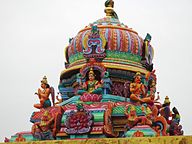Appakkudathaan Perumal Temple
| Tirupernagar | |
|---|---|
Appakkudathaan Perumal | |
 | |
| Religion | |
| Affiliation | Hinduism |
| District | Thanjavur |
| Deity | |
| Location | |
| Location | Tamilnadu |
| State | Medieval Cholas |
| Part of a series on |
| Vaishnavism |
|---|
 |
Appakkudathaan Perumal Temple or Thirupper Nagar, is a Hindu temple located in Koviladi, a village 10 miles (16 km) from
The temple is believed to be of significant antiquity, with contributions at different times from the
Legend and etymology

As per Hindu legend, the king Ubhamanyu earned the wrath of sage Durvasar and lost all his physical strength. To get rid of the curse, he was asked to feed one lakh people every day. One day, Hindu god Vishnu disguised himself as an old man, appeared before the king and asked for a meal. The king went on donating and the old man consumed all the food prepared for the people. The king was shocked and bewildered at this strange act. The old man asked for a kudam (pot) of Neyyaappam (a sweatmeal), stating that only it can fulfill his hunger. The king fulfilled the wish and later realised that it was Vishnu who had appeared as the old man. The king was relieved of the sage's curse by the blessings of Vishnu. Because of the legend, Vishnu is called "Appakkudathaan" in the temple.
It is believed that this temple is where sage
The temple has inscriptions from the 18th year of the reign of
Architecture
The temple has a three-tiered
Festivals and religious practises

The temple priests perform the pooja (rituals) every day, including festivals. Like other Vishnu temples of Tamil Nadu, the priests belong to the Vaishnavaite community, from the Brahmin varna. The temple rituals are performed four times a day; Kalasanthi at 8:30 a.m., Uchikalam at 10:00 a.m., Sayarakshai at 6:00 p.m. and Ardha Jamam at 8:00 p.m. Each ritual comprises three steps; alangaram (decoration), neivethanam (food offering) and deepa aradanai (waving of lamps) for the presiding deity. The worship involves religious instructions in the Vedas (sacred text) read by priests and prostration by worshippers in front of the temple mast. There are weekly, monthly and fortnightly rituals.
The major festivals celebrated in the temple are 13-day Panguni Brahmotsavam, Kaisika Dwadasi in Karthigai (November - December), Teertha Vari at the River Cauvery on the day of Maasi Magam (February - March) and Nammalvar Moksham during Era Pathu in Margali (December - February).
Religious significance

The
The Appakkudathaan Perumal Temple is revered in the Nalayira Divya Prabandham, a 7th–9th century Vaishnava canon of 33 verses by
References
- ^ a b c d S., Prabhu (16 September 2010). "Restoring the glory of a temple". The Hindu. Retrieved 9 September 2013.
- ISBN 81-206-0151-3.
- ^ a b c d S., Venkatraman (April 2013). "Thirupperngar". Thirukoyil. 04. 55. Hindu Religious And Endowment Board Tamil Nadu: 55–56.
- ISBN 81-206-0574-8.
- ISBN 978-81-206-0571-8.
- JSTOR 3250291.
- ^ a b "Appakudathan Temple". Dinamalar. Retrieved 4 May 2013.
- ISBN 9780953567973.
- ISBN 978-81-7755-280-5.
- ^ "Pancharanga Kshetrams". indiantemples.com. Retrieved 20 June 2007.
- ISBN 978-0-14-341421-6.
- ISBN 81-7022-857-3.
- ^ "An NGO does its bit for god - and humanity". Hindustan Times. New Delhi, India. 29 April 2007. Archived from the original on 14 April 2018. Retrieved 13 April 2018 – via HighBeam Research.
- ^ R., Dr. Vijayalakshmy (2001). An introduction to religion and Philosophy - Tévarám and Tivviyappirapantam (1st ed.). Chennai: International Institute of Tamil Studies. pp. 532–3.


